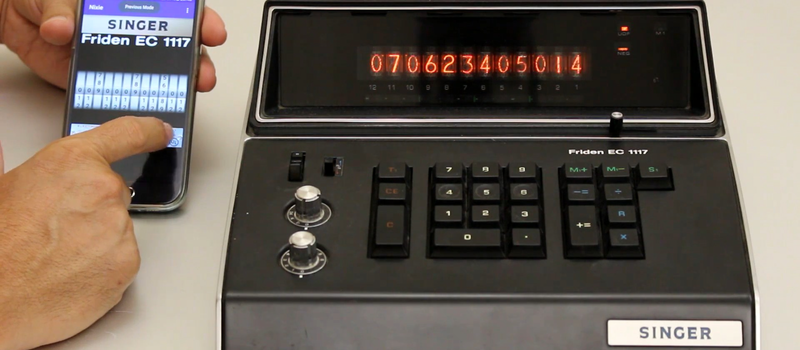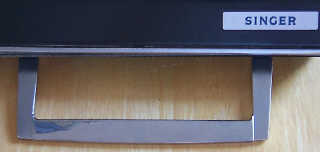Display calculator Singer, released 45 years ago, turned into a programmable clock

Singer calculators were once quite popular devices. Now in working condition there are not so many of them left. One of these calculators, the Singer / Friden EC1117 model, fell into the hands of engineer Eric Cohen, who upgraded the device by adding several advanced features.
The engineer disassembled the system, and installed the Raspberry Pi inside to control the gas-discharge lamps of the display (Hitachi CD-90 ). Then everything was simple - the craftsman installed a UDP server and wrote an Android application for managing the entire system. The calculator has remained in working condition, all previous functions work as before.
At the time of the launch of sales of the calculator, its retail price was $ 445 ($ 2,900 for today, adjusted for inflation). The calculator, despite some semblance of portability, is large. Carry it awkward.

There is even a carrying handle.
And Eric decided to turn it into a watch, adding the function of a digital display. The operation of the clock, as mentioned above, is controlled using the Android application.
Characteristics of Singer / Friden EC1117:
- Manufacturer: The Singer Company, Friden Division
- Model: EC-1117
- Date of release: 1971
- Production: Japan (Hitachi)
- Starting price: $ 445
- Weight: 3.5 kg
- Size: width 26.6 cm; length 30 cm, height 10 cm
- Power supply: 13 W, 117V AC, 50/60 Hz
- Display: gas-discharge indication, Hitachi CD-90
- Chipsets: Hitachi MOS LSI, 9 chips
- HD3201, HD3202, HN3203, HD3203, HD3205, 2-HD3206, HD3207, HD3208
- Display width: 12
- Mathematical functions: arithmetic operations - multiplication, division, subtraction, addition
The main steps performed by the developer:
- Reverse engineering of the display interface. This operation had to be carried out without diagrams and specifications.
- Connecting the Raspberry Pi to vintage electronics with a relatively high supply voltage;
- Writing a program to emulate the calculator display bus protocol.
- Run a UDP server to process remote requests received over the air:
- Writing an application for Android;
- UDP client, simple ASCII protocol;
- Support switching between multiple date and time display formats;
- Setting any values for each of the display lamps.
In order to carry out our plans, we had to work with an oscilloscope - it was necessary to carry out reverse engineering of the display interface EC1117. As soon as the engineer received the necessary data (data interface and protocol), the next step followed - connecting the Raspberry Pi 2B.

The calculator was connected to the GPIO Raspberry through logic level converters 4504. After that, a small C program was written for software emulation of the bus protocol. It allows you to decode a simple ASCII protocol, which provides the ability to change the mode of operation of the gas discharge display of the calculator over the wireless network. In particular, the developer was able to set the date / time formats and set the value of any of the device display lamps.
The development of an Android application helped the author to learn more about the Android OS and the principles of writing applications for this operating system. To control the calculator, a schematic representation of its display is used. By default, the calculator display shows the date and time, including seconds. When svayp right added a split second. When swiped to the left, the value is restored by default. The value on each of the display lamps can be changed in the application by scrolling. You can control several indicator values at the same time. There is a timer mode. A utility was also created that allows you to configure the IP and port values.
In the future, Eric plans to provide real-time OS operation (Xenomai, PremptRT and others). He also has not yet clarified for himself how the decimal point setting works, this is in the plans. Perhaps, the calculator will be able to work as a media center (what the media center means here, the author did not explain).
All technical information on the work carried out is available in the document (.pdf). The source code of the bus protocol software emulator is here . And here - a program for Android to control the display .
